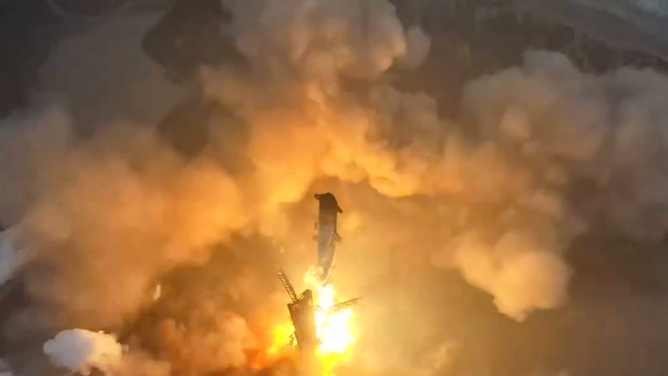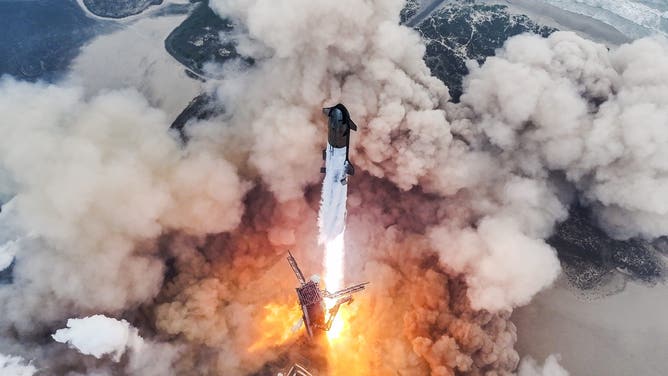SpaceX's Starship and Super Heavy booster make epic splashdowns in Gulf of Mexico, Indian Ocean
SpaceX launched Starship and the Super Heavy booster on Thursday morning from Texas on the vehicle's fourth flight test. Starship completed its first landing burn, traveling farther than in any of the three previous flight tests, making it from Texas to off the coast of Australia.
SpaceX Starship launches on fourth flight; Super Heavy booster makes first landing
SpaceX launched Starship and the Super Heavy booster from Boca Chica, Texas on June 6, 2024 on the fourth flight test. SpaceX video shows the rocket launch and booster landing about 8 minutes later.
BOCA CHICA, Texas – SpaceX achieved its most ambitious goals yet for its Starship spaceship on Thursday when the rocket's Super Heavy booster made a controlled landing in the Gulf of Mexico, and Starship landed in the Indian Ocean.
Starship and the Super Heavy booster launched from SpaceX's Starbase facility in Boca Chica, Texas, on Thursday at 8:50 a.m. ET beginning the fourth flight test for the vehicle.
The flight test is another step toward SpaceX's goal to fly humans to the Moon and beyond. NASA plans to use Starship to provide astronauts with a safe landing on the Moon under the Artemis program and SpaceX said Starship could eventually land humans on Mars.
About 8 minutes after landing, the Super Heavy booster completed a boostback burn to make a controlled landing in the Gulf of Mexico. Previous landing attempts have ended with the booster imploding before touchdown.
SpaceX employees jumped and cheered as the booster came in to land in the Gulf of Mexico.
NASA HAS A NEW GAME PLAN FOR HUBBLE SPACE TELESCOPE TO RESUME SCIENCE OBSERVATIONS
"We have splashdown," SpaceX engineer and webcast host Jessie Anderson exclaimed. "What an incredible sight!"
The video feed showed the booster in the water and some flames around it. SpaceX hasn't said what condition the Super Heavy booster is in post-landing.
If the booster landing was exciting, the Starship re-entry after a 40-minute spaceflight was even more suspenseful. SpaceX is able to provide live imagery of Starship using Starlink internet, the company's fleet of thousands of satellites orbiting Earth.
BOEING STARLINER LIFTS OFF FLYING NASA ASTRONAUTS FOR FIRST TIME

SpaceX Starship launches from Boca Chica, Texas on June 6, 2024 marking the fourth flight test for the company's reusable mega rocket.
(SpaceX)
As the spaceship began returning to Earth, the heat tiles didn't hold up, and about 32 miles above Earth, one of the Starship's landing fins began falling apart. Despite the fiery flap, Starship continued to move as though it would navigate through landing. Views from the landing attempt continued to come through as pieces of the rocket could be seen flying off.
"This is a nail-bitter," SpaceX engineer and webcast host Kate Tice said, adding the ship was likely "hanging on by a couple of bolts and threads."
Over 1 hour into the flight test, Starship completed its first landing burn, traveling farther than in any of the three previous flights, making it from Texas to the Indian Ocean in over an hour.
SpaceX CEO Elon Musk congratulated his team, saying Starship made it through the landing burn, and at least part of it landed in the Indian Ocean, northwest of Australia.

Starship re-enters Earth's atmosphere after the fourth flight test on June 6, 2024.
"Despite loss of many tiles and a damaged flap, Starship made it to a soft landing in the ocean!" Musk wrote on X.
Thursday's test flight comes just over two months after the third launch of Starship, which sent the spaceship into orbit for the first time. SpaceX has been trying to reach orbit since April 2023, and with each test, the vehicle has achieved more ambitious test flight goals.





